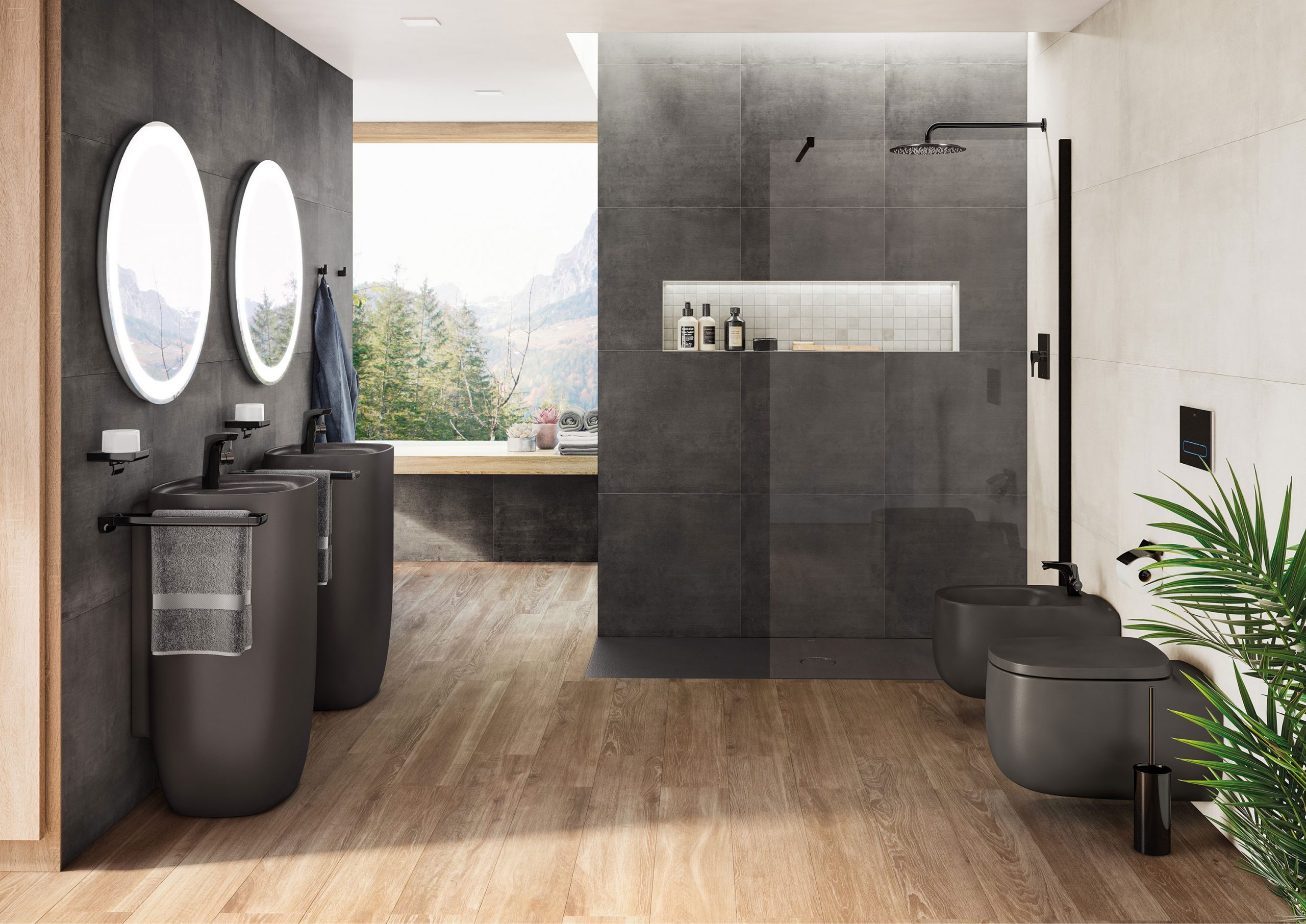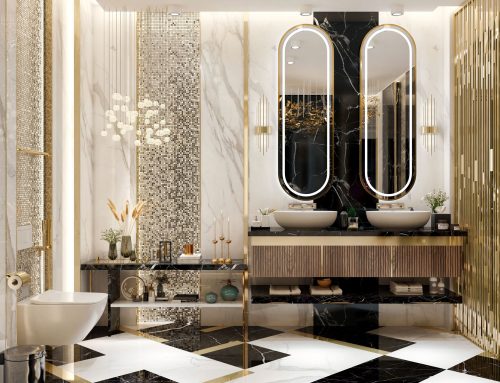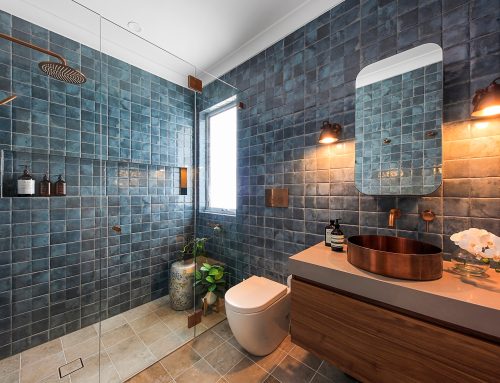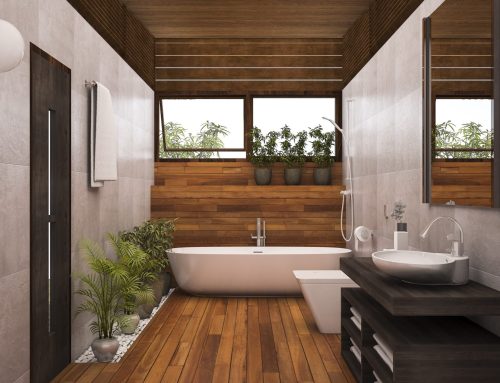The trend of bold and dark color schemes in bathroom design represents a departure from traditional whites and neutrals, embracing rich, deep hues to create a dramatic and luxurious atmosphere. This design approach challenges the notion that bathrooms should be light and airy, instead opting for bold contrasts and moody palettes to make a statement. From deep blues and greens to dramatic blacks and charcoals, the use of dark colors in the bathroom can transform the space into a sophisticated sanctuary. This comprehensive article explores the motivations behind this trend, offers guidance on incorporating bold colors effectively, and showcases inspiring examples of bathrooms that have embraced the dark side.
The Motivation Behind Bold and Dark Color Schemes
The shift towards bold and dark color schemes in bathroom design is driven by several factors, reflecting changing tastes, design trends, and lifestyle preferences. One of the primary motivations is the desire to create a more personalized and expressive space. Traditional white and neutral bathrooms, while timeless and versatile, can sometimes feel generic and lackluster. By incorporating bold colors, homeowners can infuse their bathrooms with personality and make a bold statement that reflects their individual style.
Additionally, bold and dark color schemes offer a sense of drama and sophistication that is difficult to achieve with lighter tones. These colors create a sense of depth and intimacy, enveloping the space in a cozy and luxurious ambiance. For those seeking to create a spa-like retreat or a boutique hotel-inspired bathroom, dark colors provide the perfect backdrop for achieving a sense of opulence and indulgence.
Furthermore, the rise of social media and design blogs has contributed to the popularity of bold and dark color schemes. Platforms like Instagram and Pinterest showcase a wide range of design inspirations, encouraging homeowners to experiment with unconventional color palettes and push the boundaries of traditional design norms. As a result, there is a growing appreciation for the dramatic impact that bold colors can have on a space, leading to increased interest in incorporating these hues into bathroom design.
Choosing the Right Dark Color Palette
When selecting a dark color palette for a bathroom, it’s essential to consider various factors, including the size of the space, the amount of natural light, and the desired aesthetic. While dark colors can create a striking and dramatic effect, they can also make a small or poorly lit bathroom feel cramped and gloomy if not used thoughtfully. Here are some key considerations for choosing the right dark color palette:
1. Assess the Space: Before committing to a dark color scheme, evaluate the size and layout of the bathroom. Larger bathrooms with ample natural light can accommodate deeper, more saturated colors without feeling overwhelming. In contrast, smaller bathrooms may benefit from lighter accents or strategic use of dark colors to avoid visual clutter.
2. Consider the Lighting: The amount and quality of natural and artificial lighting in the bathroom will influence how dark colors appear. Rooms with plenty of natural light can handle darker colors more effectively, while bathrooms with limited light may benefit from lighter shades or reflective surfaces to maximize brightness.
3. Think About the Mood: Dark colors evoke different emotions and moods depending on the hue and saturation. Deep blues and greens can create a sense of tranquility and relaxation, making them ideal for spa-inspired bathrooms. Rich reds and purples add warmth and intimacy, while charcoal and black exude sophistication and drama. Choose a color palette that aligns with the desired mood and ambiance of the space.
4. Balance with Lighter Elements: To prevent a dark color scheme from feeling oppressive, balance dark hues with lighter elements such as white fixtures, marble accents, or metallic finishes. These contrasting elements create visual interest and help break up the monotony of dark colors, adding depth and dimension to the design.
5. Test Samples: Before painting the entire bathroom in a dark color, test samples of different hues on the walls to see how they look in different lighting conditions. Consider how the colors interact with other elements in the space, such as tiles, countertops, and cabinetry, to ensure a cohesive and harmonious design.
Incorporating Dark Colors Effectively
Once a dark color palette has been selected, it’s essential to incorporate these hues effectively into the bathroom design to achieve the desired aesthetic impact. Here are some strategies for incorporating dark colors effectively:
1. Feature Walls: Create a focal point in the bathroom by painting one wall or a section of wall in a dark color. This approach adds visual interest and drama without overwhelming the space. Consider using a bold wallpaper or textured finish to enhance the effect further.
2. Accent Elements: Use dark colors to highlight architectural features or design elements in the bathroom. For example, painting the vanity or cabinetry in a dark color can add depth and sophistication to the space. Similarly, dark tiles or mosaic patterns can create striking accents in shower enclosures or backsplashes.
3. Contrast with Lighter Elements: Contrast dark colors with lighter elements such as white fixtures, light-colored countertops, or bright accessories to create balance and visual interest. This contrast helps prevent the space from feeling too dark or heavy and creates a dynamic interplay of light and shadow.
4. Reflective Surfaces: Incorporate reflective surfaces such as mirrors, glass, and metallic finishes to bounce light around the room and create a sense of spaciousness. Mirrored cabinets, chrome fixtures, and glossy tiles can help brighten up a dark bathroom and add a touch of glamour.
5. Layer Textures: Introduce texture into the design through materials like natural stone, wood, and textiles to add depth and warmth to the space. Textured walls, plush towels, and tactile accessories soften the look of dark colors and create a more inviting atmosphere.
Case Studies of Bold and Dark Bathrooms
To illustrate the principles and strategies discussed, let’s explore a few case studies of bathrooms that have successfully incorporated bold and dark color schemes to create striking and luxurious spaces.
Case Study 1: Midnight Blue Elegance
In this bathroom, rich midnight blue walls create a sense of depth and drama, complemented by gleaming white marble countertops and chrome fixtures. The dark hue provides a dramatic backdrop for the freestanding bathtub, which serves as the focal point of the room. Large windows flood the space with natural light, balancing the dark walls and creating a bright and airy ambiance. Brass accents and warm wood tones add warmth and sophistication, while a plush area rug softens the look and adds a touch of luxury. The overall effect is one of timeless elegance and opulent comfort.
Case Study 2: Charcoal Chic
This bathroom features a bold charcoal color scheme that exudes modern sophistication and urban chic. Floor-to-ceiling charcoal tiles create a seamless backdrop for the walk-in shower, accentuated by sleek black fixtures and matte black hardware. The dark tiles are juxtaposed with crisp white walls and countertops, creating a striking contrast that adds visual interest to the space. A large mirror reflects light and helps brighten the room, while a minimalist vanity with floating shelves maximizes storage without cluttering the space. Textured towels and potted plants add warmth and texture, softening the industrial edge of the dark color scheme.
Case Study 3: Moody Glamour
In this bathroom, a moody color palette of deep greens and rich jewel tones creates a sense of drama and glamour. Emerald green walls provide a luxurious backdrop for a freestanding bathtub, accented by brass fixtures and a crystal chandelier. Mirrored cabinets and glossy subway tiles add reflective surfaces that bounce
light around the room, enhancing the sense of spaciousness and opulence. A black and white geometric floor tile adds visual interest and echoes the Art Deco-inspired aesthetic of the space. Velvet drapes and plush rugs soften the look and add texture, while potted palms and tropical foliage bring a touch of natural elegance to the room. The overall effect is one of moody glamour and old-world charm, transporting the occupants to a bygone era of luxury and indulgence.
Case Study 4: Dramatic Monochrome
This bathroom embraces a dramatic monochrome color scheme, with black walls and white accents creating a bold and striking contrast. Matte black tiles cover the walls and floors, providing a sleek and modern backdrop for the minimalist fixtures and fittings. A freestanding bathtub takes center stage, its sculptural form standing out against the dark walls. White marble countertops and chrome fixtures add a touch of sophistication and luxury, while a large mirror reflects light and creates the illusion of space. Recessed lighting and a strategically placed skylight ensure that the room feels bright and airy despite the dark color palette. The overall effect is one of contemporary elegance and minimalist chic, with the dark hues adding depth and drama to the design.
Practical Considerations for Dark Bathrooms
While bold and dark color schemes can create stunning visual effects in the bathroom, there are some practical considerations to keep in mind when incorporating these hues into the design. Here are a few tips to ensure a successful outcome:
1. Lighting: Adequate lighting is crucial in dark bathrooms to prevent them from feeling cavernous or gloomy. Incorporate a combination of natural and artificial light sources, including overhead fixtures, wall sconces, and task lighting, to create layers of illumination. Consider installing dimmer switches to adjust the lighting levels according to the time of day and desired mood.
2. Ventilation: Dark bathrooms can be prone to moisture buildup and mold growth if not properly ventilated. Install a high-quality ventilation fan or consider adding operable windows to allow for airflow and prevent condensation. Regular cleaning and maintenance are also essential to prevent mold and mildew from forming on surfaces.
3. Contrast: To avoid a monotonous or overwhelming look, incorporate contrast into the design through the use of lighter accents, textures, and finishes. White fixtures, metallic accents, and glossy surfaces can help balance the darkness of the walls and floors, creating visual interest and depth.
4. Maintenance: Dark surfaces tend to show water spots, soap scum, and fingerprints more easily than lighter colors, so regular cleaning and maintenance are essential to keep the bathroom looking its best. Choose materials and finishes that are easy to clean and resistant to staining, such as porcelain tiles, quartz countertops, and matte paint.
5. Consider the Long-Term Impact: While bold and dark color schemes can be visually striking, they may not appeal to everyone’s tastes and preferences. Consider the long-term impact of a dark bathroom on resale value and marketability, especially if you plan to sell your home in the future. Opting for timeless and versatile design elements can help ensure broad appeal and maximize the return on your investment.
Conclusion
Bold and dark color schemes offer an exciting opportunity to create striking and memorable bathrooms that defy convention and exude sophistication. Whether you opt for deep blues, rich greens, or dramatic blacks, these hues can transform the bathroom into a luxurious sanctuary that captivates the senses and delights the soul. By carefully selecting colors, balancing contrasts, and considering practical considerations, you can create a dark bathroom that is both visually stunning and highly functional. So dare to be bold, embrace the dark side, and unleash your creativity to design a bathroom that truly makes a statement.
A division of Ross Brothers Construction Click here to see all our completed projects




